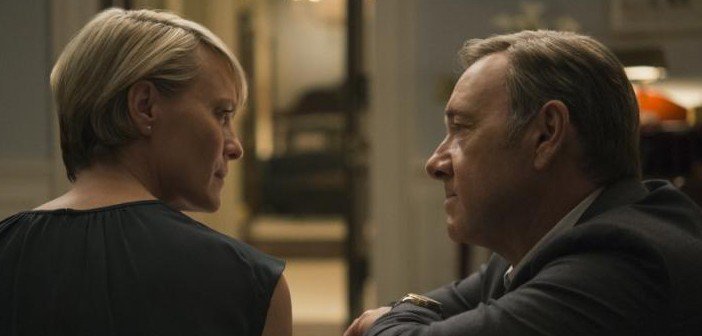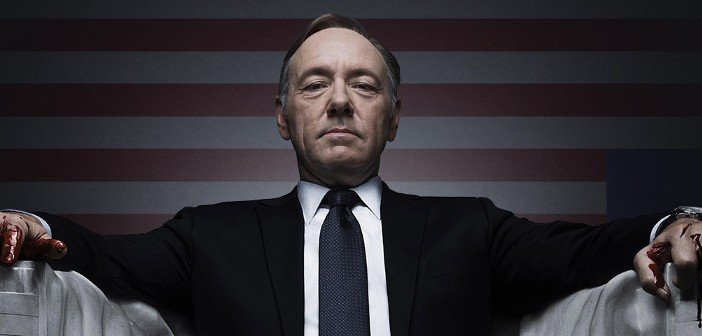Review | House of Cards Season 3: Less Trash, More Opera
The following contains mild spoilers for season three of House of Cards
A pivotal scene in the new season of House of Cards sees Kevin Spacey’s duplicitous President Underwood don military fatigues and face off with the show’s version of Vladimir Putin (Lars Mikkelsen, giving his brother a decent run for his money in the villain stakes).
President Petrov mocks his American counterpart, showing off battle scars and revealing intimate knowledge of taking a man’s life with his bare hands, an act he sneers that his rival could never do. The audience knows otherwise. Yet, Underwood, his hair increasingly greying, his plans scuppered at every turn, cuts a fairly toothless figure. We’ve seen him ruthlessly murder before, but here stands a man beaten if not broken by the role he coveted all along.
Having presented Frank Underwood as an all-dominant conqueror for two seasons, House of Cards needed to usher in the fall. That it’s a slow, often languorous burn should surprise nobody. After all, this is a production skilled in the art of the hypnotic, armed with the ability to bark jargon, reveal little and still have you hitting ‘Next Episode’ as the credits glide across the screen. It’s nice to see Underwood deal with more realistic challenges which he can’t hurl in front of a passing train in order to expunge, though his regular battles anchor this season with an explicit sense of transition.

Fans of Underwood’s Machiavellian scheming and snide breaking of the fourth wall are likely to be left as cold as the cinematography (inky greys, glacial hues and dimly-lit pristine rooms that act as prisons continue to rule) as Cards shuffles its deck, settling into a character drama and largely restricting the flow of blood. Furthering the transitional theme, it’s arguable that nothing really changes across these latest 13 episodes. Characters start in one place, move around a little, and ultimately find themselves mired in familiarity. The show may well be attempting to introduce some kind of karmic limbo motif here, but it comes to feel more like padding things out, that mid-point breather season before the final dominos really start to fall. Initially, there was talk that House of Cards would only run for two seasons. As ever, popularity dictates lifespan and thus no clear end date means no clear end game. Hell, even the product placement, though present, isn’t as transparent as it once was:
[youtube id=”MHCqw23zU_o” align=”center” autoplay=”no” maxwidth=”750"]
Season three makes as many interesting and smart choices as it does dull and questionable ones. As before, characters are teased for greater things only to vanish without trace (poor Benito Martinez) while others are drafted in and dragged out (Jimmi Simpson offers solid screen presence but his Gavin Orsay character is nothing more than a plot device). Casting remains a major strength. Petrov is such an obvious analogue for Putin that he registers as arch as you would expect, but Mikkelsen imbues him with the same icy charisma as his Sherlock super-villain while finding subtle ways in which to gobble up the scenery. Paul Sparks, resembling a sleepy splice of Jeremy Renner and Bradley Cooper, is a world away from his fast-talking Boardwalk Empire weasel Mickey Doyle. His frustrated author suffers from similar issues to those of Gavin Orsay, never fully emerging as more than a scriptwriter’s cog. Ditto for the terrific Kim Dickens, who brings the same amount of steel to her underwritten journalist as she did to Gone Girl.

As for our principals, Spacey and Wright don’t miss a step, selling the strain of their new-found power – and the isolation that comes with it – to great effect. There aren’t many showy moments this time around, and not all of what we do get works, but Wright in particular is as compelling as ever. For better and for worse, the season belongs to Michael Kelly and his still-alive and deeply troubled Doug Stamper. Frank’s former red right hand is not an easy character to spend time with yet Cards’ decision to give over the majority of its season premiere to Stamper’s long road to recovery pays off. Much like Aden Young’s stunning portrayal of the damaged Daniel Holden on Rectify, Michael Kelly says more with his eyes than most of the words thrown his way. His season-long arc culminates as it must, and though the execution feels a touch off, one notable piece of editing will live long in the memory.
House of Cards, 39 episodes and three seasons down, makes for a curious beast. It is a trashy soap opera dressed up in the finest of tailored apparel. Drama abounds, but little lies behind the eyes. As before, you’re left with the feeling that you really shouldn’t have gorged so resolutely and the knowledge that you’ll heartily embrace the emptiness once again.

